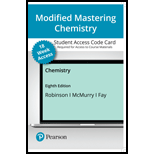
Concept explainers
(a)
Interpretation:
The shape of
Concept introduction:
The molecular structure is a 3-dimensional representation of bond pairs around the central atom. It is also known as molecular geometry. Electron geometry is a 3-dimensional representation of bond pairs and lone pair around the central atom.
(b)
Interpretation:
The shape of
Concept introduction:
The molecular structure is a 3-dimensional representation of bond pairs around the central atom. It is also known as molecular geometry. Electron geometry is a 3-dimensional representation of bond pairs and lone pair around the central atom.
Shape corresponds to electron geometry and geometry corresponds to molecular geometry or structure.
(c)
Interpretation:
The shape of
Concept introduction:
The molecular structure is a 3-dimensional representation of bond pairs around the central atom. It is also known as molecular geometry. Electron geometry is a 3-dimensional representation of bond pairs and lone pair around the central atom.
Shape corresponds to electron geometry and geometry corresponds to molecular geometry or structure.
(d)
Interpretation:
The shape of
Concept introduction:
The molecular structure is a 3-dimensional representation of bond pairs around the central atom. It is also known as molecular geometry. Electron geometry is a 3-dimensional representation of bond pairs and lone pair around the central atom.
Shape corresponds to electron geometry and geometry corresponds to molecular geometry or structure.
(e)
Interpretation:
The shape of
Concept introduction:
The molecular structure is a 3-dimensional representation of bond pairs around the central atom. It is also known as molecular geometry. Electron geometry is a 3-dimensional representation of bond pairs and lone pair around the central atom.
Shape corresponds to electron geometry and geometry corresponds to molecular geometry or structure.
(f)
Interpretation:
The shape of
Concept introduction:
The molecular structure is a 3-dimensional representation of bond pairs around the central atom. It is also known as molecular geometry. Electron geometry is a 3-dimensional representation of bond pairs and lone pair around the central atom.
Shape corresponds to electron geometry and geometry corresponds to molecular geometry or structure.
Want to see the full answer?
Check out a sample textbook solution
Chapter 8 Solutions
CHEMISTRY-MOD.MASTERING (18W)
- Complete the following acid-base reactions and predict the direction of equilibrium for each. Justify your prediction by citing pK values for the acid and conjugate acid in each equilibrium. (a) (b) NHs (c) O₂N NH NH OH H₁PO₁arrow_forward23.34 Show how to convert each starting material into isobutylamine in good yield. ཅ ནད ཀྱི (b) Br OEt (c) (d) (e) (f) Harrow_forwardPlease help me Please use https://app.molview.com/ to draw this. I tried, but I couldn't figure out how to do it.arrow_forward
- Propose a synthesis of 1-butanamine from the following: (a) a chloroalkane of three carbons (b) a chloroalkane of four carbonsarrow_forwardSelect the stronger base from each pair of compounds. (a) H₂CNH₂ or EtzN (b) CI or NH2 NH2 (c) .Q or EtzN (d) or (e) N or (f) H or Harrow_forward4. Provide a clear arrow-pushing mechanism for each of the following reactions. Do not skip proton transfers, do not combine steps, and make sure your arrows are clear enough to be interpreted without ambiguity. a. 2. 1. LDA 3. H3O+ HOarrow_forward
- b. H3C CH3 H3O+ ✓ H OHarrow_forward2. Provide reagents/conditions to accomplish the following syntheses. More than one step is required in some cases. a. CH3arrow_forwardIdentify and provide an explanation that distinguishes a qualitative and quantitative chemical analysis. Provide examples.arrow_forward
- Identify and provide an explanation of the operational principles behind a Atomic Absorption Spectrometer (AAS). List the steps involved.arrow_forwardInstructions: Complete the questions in the space provided. Show all your work 1. You are trying to determine the rate law expression for a reaction that you are completing at 25°C. You measure the initial reaction rate and the starting concentrations of the reactions for 4 trials. BrO³¯ (aq) + 5Br¯ (aq) + 6H* (aq) → 3Br₂ (l) + 3H2O (l) Initial rate Trial [BrO3] [H*] [Br] (mol/L) (mol/L) | (mol/L) (mol/L.s) 1 0.10 0.10 0.10 8.0 2 0.20 0.10 0.10 16 3 0.10 0.20 0.10 16 4 0.10 0.10 0.20 32 a. Based on the above data what is the rate law expression? b. Solve for the value of k (make sure to include proper units) 2. The proposed reaction mechanism is as follows: i. ii. BrО¸¯ (aq) + H+ (aq) → HBrO3 (aq) HBrO³ (aq) + H* (aq) → H₂BrO3* (aq) iii. H₂BrO³* (aq) + Br¯ (aq) → Br₂O₂ (aq) + H2O (l) [Fast] [Medium] [Slow] iv. Br₂O₂ (aq) + 4H*(aq) + 4Br(aq) → 3Br₂ (l) + H2O (l) [Fast] Evaluate the validity of this proposed reaction. Justify your answer.arrow_forwardе. Д CH3 D*, D20arrow_forward
 Chemistry: Principles and PracticeChemistryISBN:9780534420123Author:Daniel L. Reger, Scott R. Goode, David W. Ball, Edward MercerPublisher:Cengage Learning
Chemistry: Principles and PracticeChemistryISBN:9780534420123Author:Daniel L. Reger, Scott R. Goode, David W. Ball, Edward MercerPublisher:Cengage Learning Chemistry: The Molecular ScienceChemistryISBN:9781285199047Author:John W. Moore, Conrad L. StanitskiPublisher:Cengage Learning
Chemistry: The Molecular ScienceChemistryISBN:9781285199047Author:John W. Moore, Conrad L. StanitskiPublisher:Cengage Learning Chemistry by OpenStax (2015-05-04)ChemistryISBN:9781938168390Author:Klaus Theopold, Richard H Langley, Paul Flowers, William R. Robinson, Mark BlaserPublisher:OpenStax
Chemistry by OpenStax (2015-05-04)ChemistryISBN:9781938168390Author:Klaus Theopold, Richard H Langley, Paul Flowers, William R. Robinson, Mark BlaserPublisher:OpenStax Chemistry & Chemical ReactivityChemistryISBN:9781133949640Author:John C. Kotz, Paul M. Treichel, John Townsend, David TreichelPublisher:Cengage Learning
Chemistry & Chemical ReactivityChemistryISBN:9781133949640Author:John C. Kotz, Paul M. Treichel, John Townsend, David TreichelPublisher:Cengage Learning



